Sharp AR-5623, AR-5618D, AR-5620, AR-5623D, AR-5620D Manual
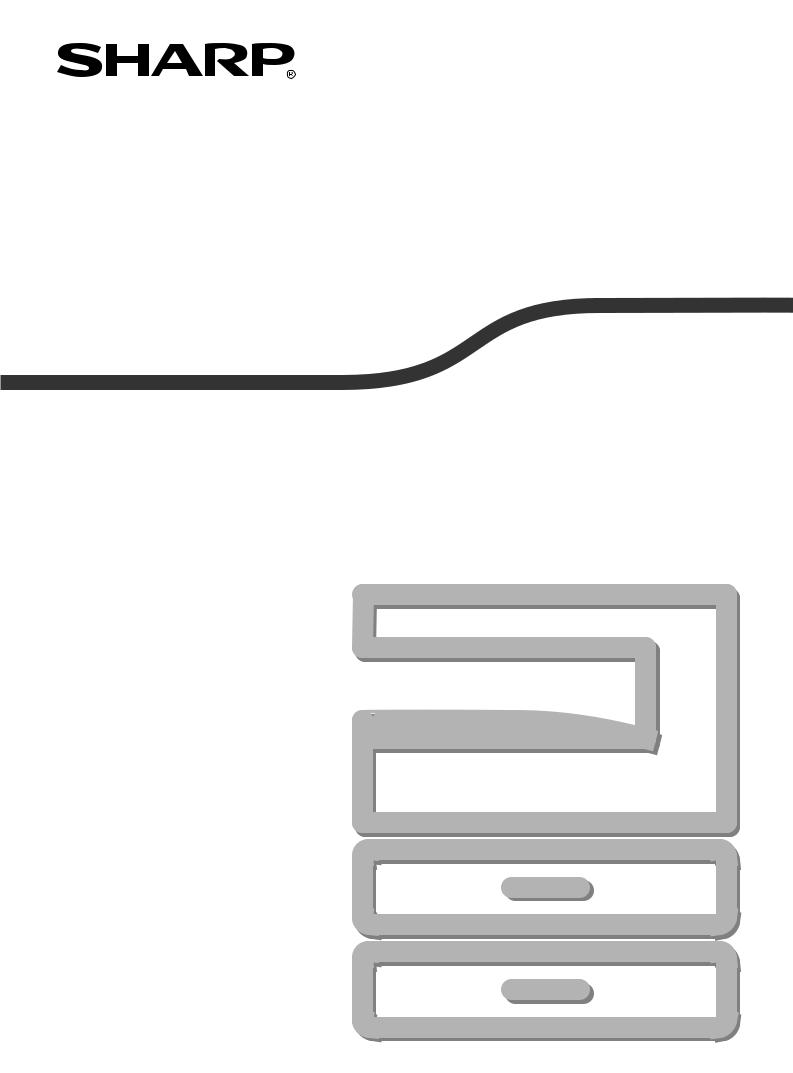
MODEL: AR-5618
AR-5620
AR-5623
AR-5618D
AR-5620D
AR-5623D
DIGITAL MULTIFUNCTIONAL SYSTEM
OPERATION GUIDE
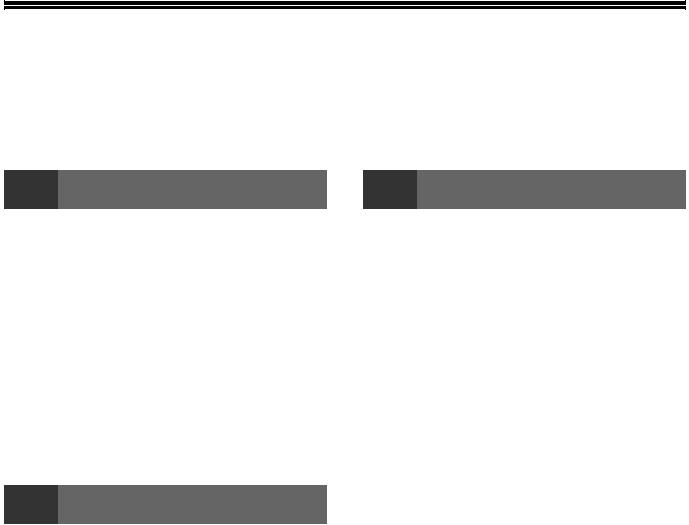
CONTENTS |
|
INTRODUCTION ................................................ |
4 |
USING THE MANUAL ....................................... |
4 |
DIFFERENCES BETWEEN MODELS............... |
5 |
1 SETUP |
|
BEFORE SOFTWARE SETUP .......................... |
6 |
● SOFTWARE...................................................... |
6 |
● HARDWARE AND SOFTWARE |
|
REQUIREMENTS ............................................. |
6 |
● POWER ON THE MACHINE ............................ |
6 |
INSTALLING THE SOFTWARE ........................ |
7 |
CONNECTING TO A COMPUTER .................... |
9 |
● CONNECTING A USB CABLE ......................... |
9 |
● USING THE MACHINE AS A SHARED |
|
PRINTER ........................................................ |
10 |
CONFIGURING THE PRINTER DRIVER ........ |
11 |
SETTING UP BUTTON MANAGER ................ |
12 |
TROUBLESHOOTING ..................................... |
14 |
2 BEFORE USING THE MACHINE |
|
PART NAMES AND FUNCTIONS ................... |
16 |
● OPERATION PANEL ...................................... |
18 |
POWER ON AND OFF..................................... |
20 |
● POWER ON .................................................... |
20 |
● POWER OFF .................................................. |
20 |
LOADING PAPER............................................ |
21 |
● PAPER............................................................ |
21 |
● LOADING PAPER........................................... |
22 |
● CHANGING A TRAY'S PAPER SIZE SETTING .... |
24 |
OPERATION IN COPY, PRINTER, AND |
|
SCANNER MODES.......................................... |
26 |
3 |
COPY FUNCTIONS |
|
NORMAL COPYING ........................................ |
27 |
|
● MAKING A COPY DARKER OR LIGHTER ... |
30 |
|
● SELECTING THE TRAY................................ |
30 |
|
● SETTING THE NUMBER OF COPIES .......... |
31 |
|
REDUCTION/ENLARGEMENT/ZOOM ........... |
31 |
|
● AUTOMATIC RATIO SELECTION................. |
31 |
|
● MANUAL RATIO SELECTION....................... |
32 |
|
● SELECTING THE VERTICAL AND |
|
|
|
HORIZONTAL COPY RATIOS SEPARATELY |
|
|
(XY ZOOM Copying)...................................... |
33 |
AUTOMATIC TWO-SIDED COPYING (AR- |
|
|
5618D/AR-5620D/AR-5623D).......................... |
35 |
|
● IMAGE ROTATION IN DUPLEX COPYING .... |
37 |
|
TWO-SIDED COPYING USING THE BYPASS |
|
|
TRAY................................................................ |
38 |
|
DUAL PAGE COPYING................................... |
39 |
|
INTERRUPTING A COPY RUN (Interrupt |
|
|
Copying).......................................................... |
40 |
|
CONVENIENT COPY FUNCTIONS................. |
41 |
|
● ROTATING THE IMAGE 90 DEGREES |
|
|
|
(Rotation Copy).............................................. |
41 |
● SORT COPY/GROUP COPY......................... |
41 |
|
●COPYING MULTIPLE ORIGINALS ONTO A SINGLE SHEET OF PAPER (2 IN 1 / 4 IN 1
Copy) ............................................................. |
43 |
● CREATING MARGINS WHEN COPYING |
|
(Margin Shift) ................................................. |
45 |
● ERASING SHADOWS AROUND THE EDGES |
|
OF A COPY (Erase Copy) ............................. |
46 |
● ID CARD COPY ............................................. |
47 |
1
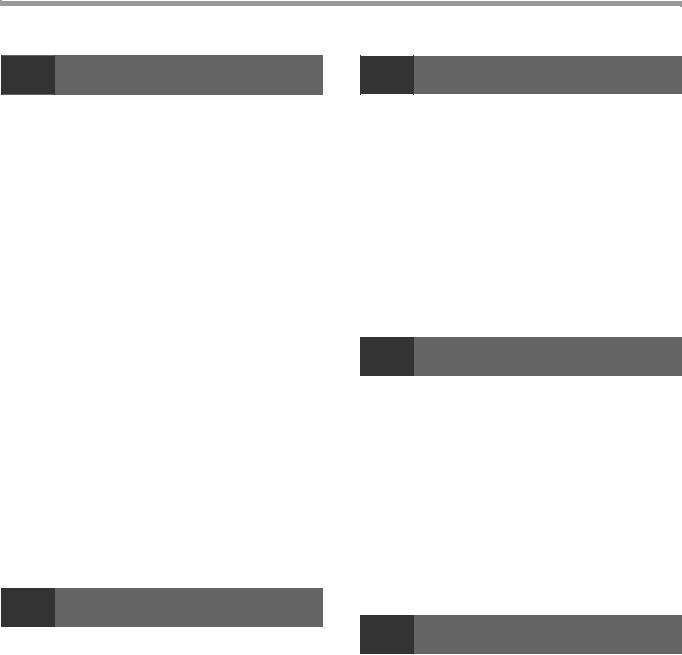
4 |
PRINTER FUNCTIONS |
|
BASIC PRINTING ............................................ |
48 |
|
● OPENING THE PRINTER DRIVER FROM THE |
||
|
"Start" BUTTON .............................................. |
49 |
PRINTER DRIVER SETTING SCREEN........... |
50 |
|
SETTING ADVANCED PRINT FUNCTIONS... |
51 |
|
● PRINTING MULTIPLE PAGES ON ONE PAGE |
||
|
(N-Up Printing) ................................................ |
51 |
● FITTING THE PRINTED IMAGE TO THE |
|
|
|
PAPER (Fit To Paper Size)............................. |
52 |
● ROTATING THE PRINT IMAGE 180 DEGREES |
||
|
(Rotate 180 degrees) ...................................... |
52 |
● ENLARGING/REDUCING THE PRINT IMAGE |
||
|
(Zoom) ............................................................ |
53 |
● PRINTING FAINT TEXT AND LINES IN BLACK |
||
|
(Text To Black/Vector To Black) ..................... |
53 |
●ADJUSTING THE BRIGHTNESS AND CONTRAST OF THE IMAGE (Image
|
Adjustment)..................................................... |
54 |
● ADDING A WATERMARK TO PRINTED PAGES |
||
|
(Watermark) ..................................................... |
54 |
● TWO-SIDED PRINTING (AR-5618D/AR-5620D/AR- |
||
|
5623D) .................................................................... |
55 |
SAVING FREQUENTLY USED PRINT |
|
|
SETTINGS........................................................ |
56 |
|
● SAVING SETTINGS AT THE TIME OF |
|
|
|
PRINTING (User Settings).............................. |
56 |
OUTLINE OF THE PRINT STATUS WINDOW..... |
57 |
|
5 |
SCANNER FUNCTIONS |
|
SCANNING OVERVIEW .................................. |
58 |
|
SCANNING USING THE KEYS ON THE |
|
|
MACHINE......................................................... |
59 |
|
● OUTLINE OF BUTTON MANAGER ............... |
60 |
|
● BUTTON MANAGER SETTINGS ................... |
61 |
|
SCANNING FROM YOUR COMPUTER.......... |
62 |
|
● SCANNING FROM A TWAIN-COMPLIANT |
|
|
|
APPLICATION .................................................. |
62 |
● SCANNING FROM A WIA-COMPLIANT |
|
|
|
APPLICATION (Windows XP/Vista/7) ............ |
66 |
● SCANNING FROM THE "Scanner and Camera |
||
|
Wizard" (Windows XP).................................... |
67 |
6 |
USER SETTINGS |
|
ADJUSTING THE AUTOMATIC EXPOSURE |
|
|
LEVEL.............................................................. |
68 |
|
TONER SAVE MODE AND HIGH IMAGE |
|
|
QUALITY MODE.............................................. |
69 |
|
CUSTOMISING SETTINGS (System Settings)...... |
70 |
|
● SYSTEM SETTINGS ..................................... |
70 |
|
● SELECTING A SETTING FOR A SYSTEM |
|
|
|
SETTING ....................................................... |
74 |
SETTINGS FOR AUDITING MODE................. |
75 |
|
● AUDITING MODE .......................................... |
75 |
|
● AUDITING MODE SETTINGS ....................... |
75 |
|
● SELECTING AUDITING MODE SETTINGS ..... |
76 |
|
7 |
TROUBLESHOOTING |
|
TROUBLESHOOTING..................................... |
79 |
|
● MACHINE/COPYING PROBLEMS................ |
80 |
|
● PRINTING AND SCANNING PROBLEMS ...... |
83 |
|
INDICATORS AND DISPLAY MESSAGES........ |
87 |
|
MISFEED REMOVAL ...................................... |
88 |
|
● MISFEED IN THE SPF/RSPF........................ |
88 |
|
● MISFEED IN THE BYPASS TRAY ................ |
89 |
|
● MISFEED IN THE MACHINE......................... |
90 |
|
● MISFEED IN THE UPPER PAPER TRAY ....... |
93 |
|
● MISFEED IN THE LOWER PAPER TRAY .... |
94 |
|
REPLACING THE TONER CARTRIDGE ........ |
95 |
|
8 |
ROUTINE MAINTENANCE |
|
CHECKING THE TOTAL OUTPUT COUNT AND |
||
TONER LEVEL ................................................ |
96 |
|
● CHECKING THE TOTAL OUTPUT COUNT ...... |
96 |
|
● CHECKING THE TONER LEVEL .................. |
97 |
|
ROUTINE MAINTENANCE.............................. |
98 |
|
● CLEANING THE DOCUMENT GLASS AND |
|
|
|
SPF/RSPF/DOCUMENT COVER .................. |
98 |
● CLEANING THE ORIGINAL SCANNING GLASS |
||
|
(ONLY WHEN AN SPF/RSPF IS INSTALLED) ... |
98 |
● CLEANING THE BYPASS TRAY PAPER FEED |
||
|
ROLLER......................................................... |
99 |
● CLEANING THE TRANSFER CHARGER ....... |
99 |
|
2

9 |
APPENDIX |
|
SPECIFICATIONS (PRINTER AND SCANNER).... |
100 |
|
● PRINTER FUNCTION................................... |
100 |
|
● SCANNER FUNCTION................................. |
101 |
|
PERIPHERAL DEVICES................................ |
102 |
|
● SINGLE PASS FEEDER/REVERSING SINGLE |
||
|
PASS FEEDER............................................. |
103 |
● DOCUMENT COVER ................................... |
103 |
|
● 250-SHEET PAPER FEED UNIT/2 X 250- |
|
|
|
SHEET PAPER FEED UNIT......................... |
104 |
STORAGE OF SUPPLIES ............................. |
105 |
|
● PROPER STORAGE .................................... |
105 |
|
3
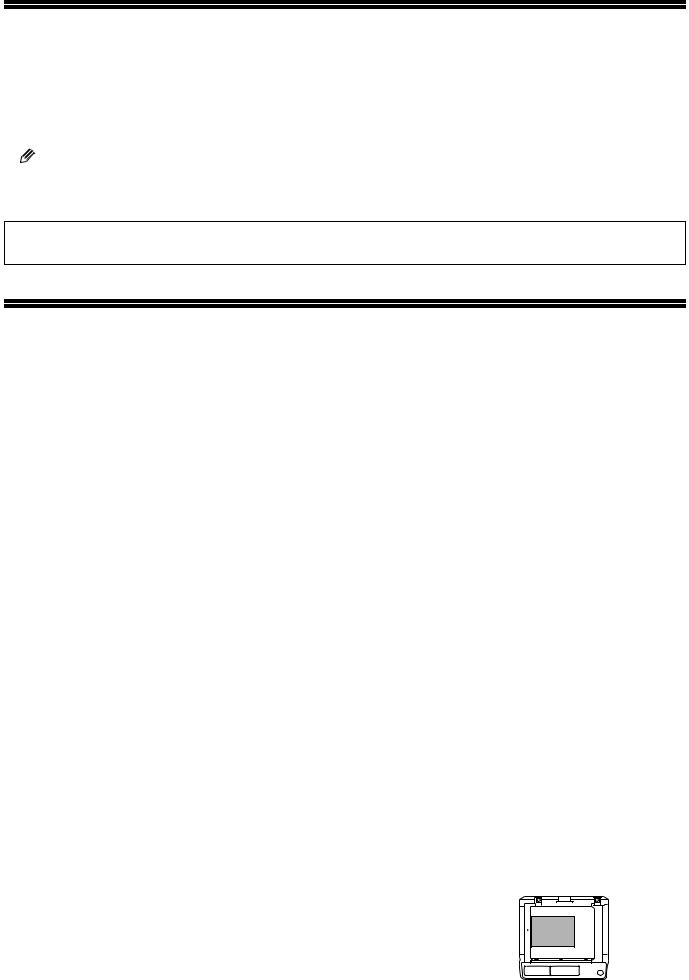
INTRODUCTION
This manual describes the copier, printer, and scanner functions of the AR-5618/AR-5620/AR-5623 and AR-5618D/ AR-5620D/AR-5623D digital multifunctional system.
|
|
• |
Where "AR-XXXX" appears in this manual, please substitute the name of your model for "XXXX". For the name |
|
Note |
|
of your model, see "DIFFERENCES BETWEEN MODELS" (p.5). |
|
• |
The screen images and procedures that appear in this manual are mainly for Windows Vista. With other |
|
|
|
|
versions of Windows, some screen images may be different from those in this manual. |
|
|
• |
For information on using your operating system, refer to your operating system's manual or online Help. |
|
|
|
|
The display screens, messages, and key names shown in the manual may differ from those on the actual machine due to product improvements and modifications.
USING THE MANUAL
This machine has been designed to provide convenient copying features in a minimum amount of office space and with maximum operational ease. To get full use of all machine features, be sure to familiarise yourself with this manual and the machine. For quick reference during machine use, SHARP recommends printing out this manual and keep it in a handy location.
ABOUT THE MANUALS
The manuals for the machine are as follows:
Start Guide
This manual explains:
•Specifications
•Cautions for using the machine in safety
Operation Guide (on the accessory CD-ROM)
This manual explains:
•How to install the software that allows the machine to be used as a printer and scanner for your computer
•Part names of the machine
•Available paper type for this machine
•Basic copy procedure and advanced copy functions
(For example: rotating the image 90 degrees, copying multiple originals onto a single sheet of paper)
•Basic print procedure and other frequently used print functions
(For example: fitting the printed image to the paper, enlarging/reducing the print image)
•Scanning on the machine and from a computer
•Toner cartridge replacement and peripheral devices
•Troubleshooting for using the machine
THE MEANING OF "R" IN ORIGINAL AND PAPER SIZE INDICATIONS
An "R" appearing at the end of an original or paper size (A4R (5-1/2" x 8-1/ 2"R, 8-1/2" x 11"R), etc.) indicates that the original or paper is oriented horizontally as shown on the right.
Sizes that can be placed only in the horizontal (landscape) orientation (B4, A3 (8-1/2" x 14", 11" x 17")) do not contain the "R" in their size indication.
<Horizontal (Landscape) orientation>
4
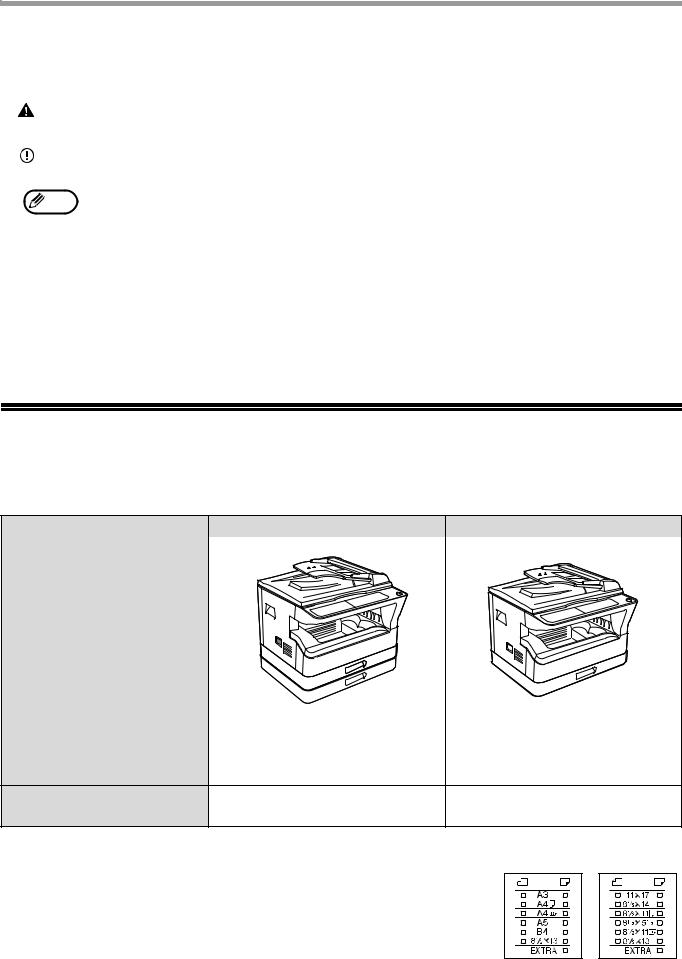
CONVENTIONS USED IN THIS MANUAL
|
Warning |
Warns the user that injury may result if the contents of the warning are not properly followed. |
|
|
Cautions the user that damage to the machine or one of its components may result if the contents |
|
|
|
|
Caution |
|
|
of the caution are not properly followed. |
|
|
Note |
Notes provide information relevant to the machine regarding specifications, functions, |
|
performance, operation and such, that may be useful to the user. |
SPF (AR-5618/AR-5620/AR-5623)
This manual refers to the Single Pass Feeder as the "SPF".
RSPF (AR-5618D/AR-5620D/AR-5623D)
This manual refers to the Reversing Single Pass Feeder as the "RSPF".
DIFFERENCES BETWEEN MODELS
This manual covers the following models.
Model |
AR-5620/AR-5623/AR-5620D/AR-5623D |
AR-5618/AR-5618D |
|
(With optional SPF/RSPF installed) |
(With optional SPF/RSPF installed) |
Appearance
The above illustration is used in instances where a function and/ or the operation of the machine is the same on both models.
Copy speed |
20CPM/23CPM |
18CPM |
Paper trays |
Two (250 x 2) |
One (250 x 1) |
AB series (metric) and inch series references
Both specifications are quoted where applicable.
For example: |
|
|
|
Page 4.................................. |
B4 and A3 (8-1/2" x 14" and 11" x 17") |
|
|
Start Guide ........................... |
50%, 70%, 81%, 86%, 100%, 115%, 122%, 141%, |
|
|
|
200% (50%, 64%, 77%, 95%, 100%, 121%, 129%, |
[AB series] |
[Inch series] |
|
141%, 200%) |
Although AB series size indications are shown on the operation panel of this manual, inch series indications are displayed on the inch series machines.
5

1 |
Chapter 1 |
||
SETUP |
|||
|
|
|
|
|
|
|
|
BEFORE SOFTWARE SETUP
This chapter explains how to install and configure the software that is required for the printer and scanner functions of the machine.
 Note This manual refers to the CD-ROM that accompanied the machine simply as "CD-ROM".
Note This manual refers to the CD-ROM that accompanied the machine simply as "CD-ROM".
SOFTWARE
The CD-ROM that accompanies the machine contains the following software:
MFP driver
Printer driver
The printer driver enables you to use the printer function of the machine.
The printer driver includes the Print Status Window. This is a utility that monitors the machine and informs you of the printing status, the name of the document currently being printed, and error messages.
Scanner driver
The scanner driver allows you to use the scanning function of the machine with TWAIN-compliant and WIA-compliant applications.
Button Manager
Button Manager allows you to use the scanner menus on the machine to scan a document.
HARDWARE AND SOFTWARE REQUIREMENTS
Check the following hardware and software requirements before installing the software.
Computer type |
IBM PC/AT or compatible computer equipped with a USB 2.0*1/1.1*2 |
Operating system*3
Windows 2000 Professional, Windows XP Professional, Windows XP Home Edition, Windows
Vista, Windows 7
Other hardware requirements An environment on which any of the operating systems listed above can fully operate
*1The machine's USB 2.0 port will transfer data at the speed specified by the USB 2.0 (Hi-Speed) only if the Microsoft USB 2.0 driver is preinstalled in the computer, or if the USB 2.0 driver for Windows 2000 Professional/XP/Vista/7 that Microsoft provides through its "Windows Update" is installed.
*2Compatible with Windows 2000 Professional, Windows XP Professional, Windows XP Home Edition, Windows Vista, or Windows 7 preinstalled models equipped with a USB interface as standard.
*3• The machine does not support printing from a Macintosh environment.
• Administrator’s rights are required to install the software using the installer.
POWER ON THE MACHINE
The power switch is located on the left side of the machine.

 Turn the power switch to the "ON" position.
Turn the power switch to the "ON" position.
6

INSTALLING THE SOFTWARE
• |
The screen images in this manual are mainly for Windows Vista. With other versions of Windows, some screen |
Note |
images may be different from those in this manual. |
•If an error message appears, follow the instructions on the screen to solve the problem. After the problem is solved, the installation procedure will continue. Depending on the problem, you may have to click the "Cancel" button to exit the installer. In this case, reinstall the software from the beginning after solving the problem.
1 The USB cable must not be connected to the machine. Make sure that the cable is not connected before proceeding.
If the cable is connected, a Plug and Play window will appear. If this happens, click the "Cancel" button to close the window and disconnect the cable.
 Note The cable will be connected in step 12.
Note The cable will be connected in step 12.
2 Insert the CD-ROM into your CD-ROM drive.
3 Click the "Start" button, click "Computer", and then double-click the CD-ROM icon (  ).
).
•In Windows XP, click the "start" button, click "My Computer", and then double-click the CD-ROM icon.
•In Windows 2000, double-click "My Computer", and then double-click the CD-ROM icon.
4 Double-click the "Setup" icon ( ).
).
•In Windows 7, if a message screen appears asking you for confirmation, click "Yes".
•In Windows Vista, if a message screen appears asking you for confirmation, click "Allow".
5 The "SOFTWARE LICENSE" window will appear. Make sure that you understand the contents of the software license, and then click the "Yes" button.
You can show the "SOFTWARE LICENSE" in 
 Note a different language by selecting the desired language from the language menu. To install
Note a different language by selecting the desired language from the language menu. To install
the software in the selected language, continue the installation with that language selected.
6 Read the message in the "Welcome" window and then click the "Next"
button.
1
7 To install all of the software, click the "Standard" button and go to step 11. To install particular packages, click the "Custom" button and go to the next step.
8 Click the "MFP Driver" button.
Click the "Display Readme" button to show information on packages that are selected.
7
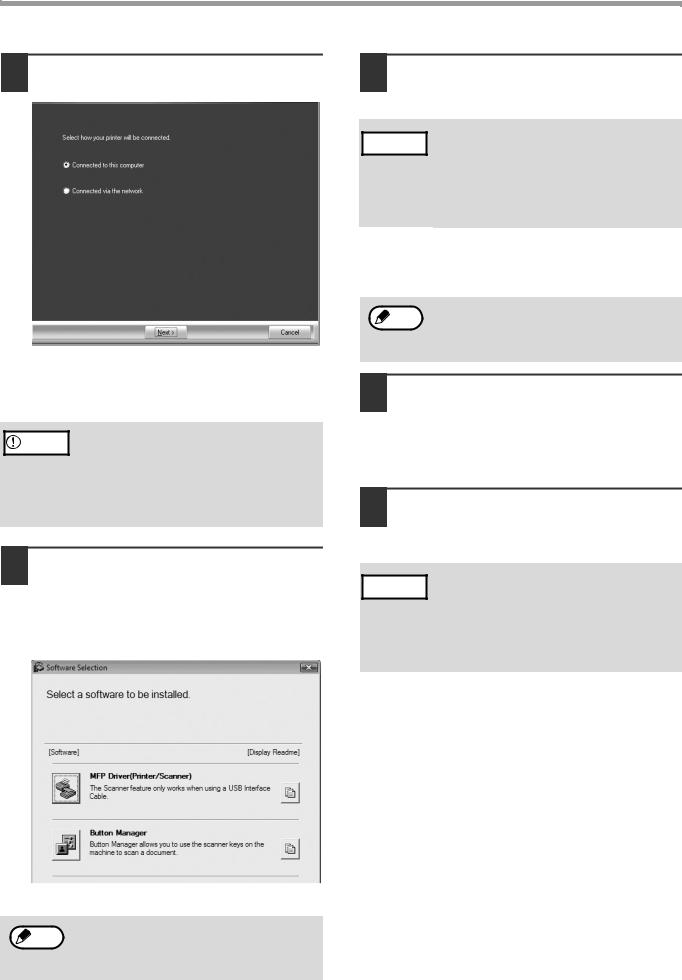
SETUP
9 Select "Connected to this computer" and click the "Next" button.
Follow the on-screen instructions.
When "The installation of the SHARP software is complete." appears, click the "OK" button.
• |
If you are using Windows Vista/7 and a |
Caution |
security warning window appears, be sure |
|
to click "Install this driver software anyway". |
•If you are running Windows 2000/XP and a warning message appears regarding the Windows logo test or digital signature, be sure to click "Continue Anyway" or "Yes".
10 You will return to the window of step
8. If you wish to install Button Manager, click the "Button Manager" button.
If you do not wish to install the Button Manager, go to step 11.
Follow the on-screen instructions.
After the installation, a message prompting 
 Note you to restart your computer may appear. In
Note you to restart your computer may appear. In
this case, click the "Yes" button to restart your computer.
11 When installing is finished, click the "Close" button.
• If you are using Windows Vista/7 and a  Caution security warning window appears, be sure
Caution security warning window appears, be sure
to click "Install this driver software anyway".
•If you are running Windows 2000/XP and a warning message appears regarding the Windows logo test or digital signature, be sure to click "Continue Anyway" or "Yes".
A message will appear instructing you to connect the machine to your computer. Click the "OK" button.
After the installation, a message prompting 
 Note you to restart your computer may appear. In
Note you to restart your computer may appear. In
this case, click the "Yes" button to restart your computer.
12 Make sure that the power of the machine is turned on, and then connect the USB cable (p.9).
Windows will detect the machine and a Plug and Play window will appear.
13 Follow the instructions in the Plug and Play window to install the driver.
Follow the on-screen instructions.
• If you are using Windows Vista/7 and a  Caution security warning window appears, be sure
Caution security warning window appears, be sure
to click "Install this driver software anyway".
•If you are running Windows 2000/XP and a warning message appears regarding the Windows logo test or digital signature, be sure to click "Continue Anyway" or "Yes".
This completes the installation of the software.
•If you installed Button Manager, set up Button Manager as explained in "SETTING UP BUTTON MANAGER" (p.12)
8
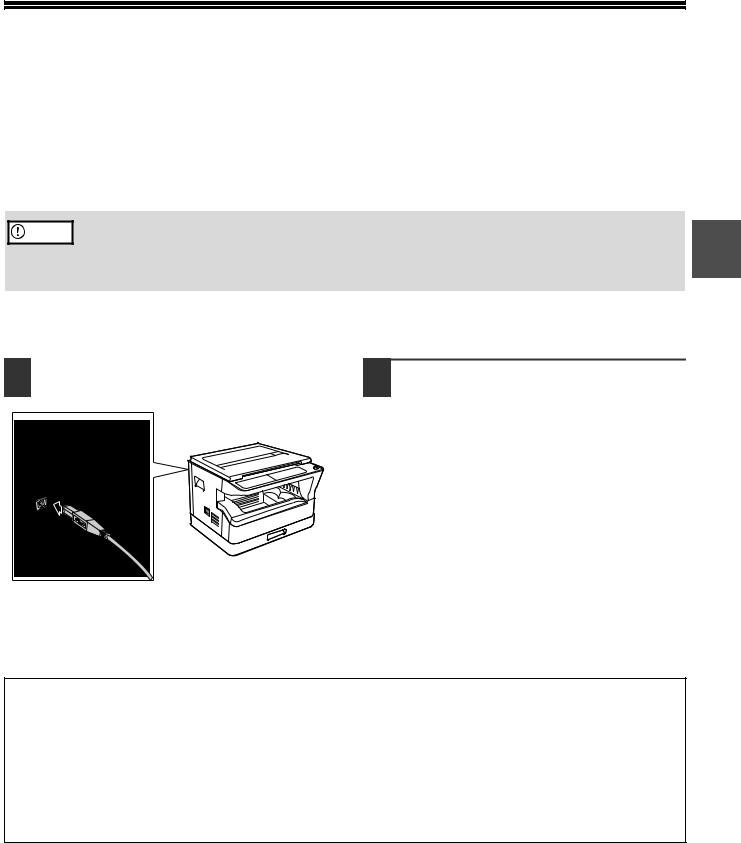
CONNECTING TO A COMPUTER
Follow the procedure below to connect the machine to your computer.
A USB cable for connecting the machine to your computer is not included with the machine. Please purchase the appropriate cable for your computer.
Interface cable
USB cable
Shielded twisted pair cable, high-speed transmission equivalent (3 m (10 feet) max.)
If the machine will be connected using a USB 2.0 interface, please purchase a USB cable that supports USB 2.0.
• |
USB is available with a PC/AT compatible computer that was originally equipped with USB and had Windows |
1 |
Caution |
2000 Professional, Windows XP Professional, Windows XP Home Edition, Windows Vista, or Windows 7 |
|
|
preinstalled. |
|
• |
Do not connect the USB cable before installing the MFP driver. The USB cable should be connected during |
|
|
installation of the MFP driver. |
|
CONNECTING A USB CABLE
1 Insert the cable into the USB connector on the machine.
2 Insert the other end of the cable into your computer's USB connector.
System requirements for USB 2.0 (Hi-Speed mode)
•The machine's USB 2.0 connector will transfer data at the speed specified by the USB 2.0 (Hi-Speed) only if the Microsoft USB 2.0 driver is preinstalled in the computer, or if the USB 2.0 driver for Windows 2000 Professional /XP/Vista/7 that Microsoft provides through its "Windows Update" Web page is installed.
•Even when the Microsoft USB 2.0 driver is used, it may not be possible to obtain full USB 2.0 speed if a PC card supporting USB 2.0 is used. To obtain the latest driver (which may enable a higher speed), contact the manufacturer of your PC card.
•Connection is also possible using a USB 1.1 port on your computer. However, the specifications will be USB 1.1 specifications (Full-Speed).
9
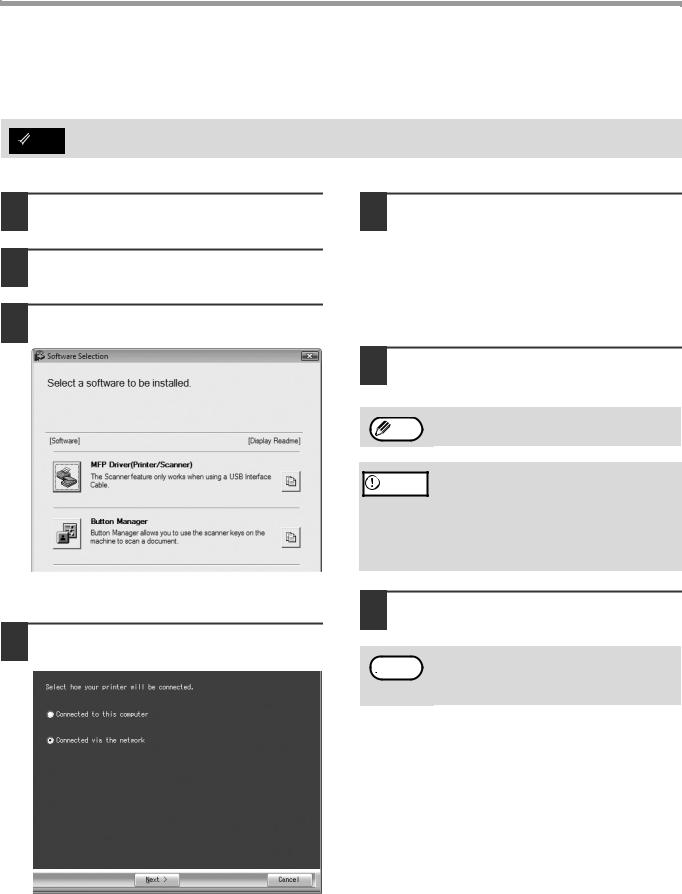
SETUP
USING THE MACHINE AS A SHARED PRINTER
If the machine will be used as a shared printer on a Windows network, follow these steps to install the printer driver in the client computer.
To configure the appropriate settings in the print server, see the operation manual or help file of your operating Note system.
1 Perform steps 2 through 6 in "INSTALLING THE SOFTWARE" (p.7).
2 Click the "Custom" button.
3 Click the "MFP Driver" button.
Click the "Display Readme" button to show information on packages that are selected.
4 Select "Connected via the network" and click the "Next" button.
5 Select the printer name (configured as a shared printer on a print server) from the list.
In Windows 2000/XP, you can also click the "Add Network Port" button displayed below the list and select the printer to be shared by browsing the network in the window that appears.
6 Click the "Next" button.
Follow the on-screen instructions.
Note |
If the shared printer does not appear in the |
list, check the settings on the print server. |
• |
If you are using Windows Vista/7 and a |
Caution |
security warning window appears, be sure |
|
to click "Install this driver software anyway". |
•If you are running Windows 2000/XP and a warning message appears regarding the Windows logo test or digital signature, be sure to click "Continue Anyway" or "Yes".
7 You will return to the window of step 3. Click the "Close" button.
After the installation, a message prompting  Note you to restart your computer may appear. In
Note you to restart your computer may appear. In
this case, click the "Yes" button to restart your computer.
This completes the installation of the software.
10

CONFIGURING THE PRINTER DRIVER
After installing the printer driver, you must configure the printer driver settings appropriately for the number of paper trays on the machine and the size of paper loaded in each.
1 Click the "Start" button, click "Control Panel", and then click "Printer".
•In Windows 7, click the "Start" button and then click "Devices and Printers".
•In Windows XP, click the "start" button and click "Printers and Faxes".
•In Windows 2000, click the "Start" button, select "Settings", and then click "Printers".
In Windows XP, if "Printers and Faxes" does 
 Note not appear in the "start" menu, select "Control Panel", select "Printers and Other Hardware",
Note not appear in the "start" menu, select "Control Panel", select "Printers and Other Hardware",
and then select "Printers and Faxes".
2 Click the "SHARP AR-XXXX" printer driver icon and select "Properties" from the "Organize" menu.
•In Windows 7, right-click the "SHARP AR-XXXX" printer driver icon, and then click "Printer properties".
•In Windows XP/2000, select "Properties" from the "File" menu.
3 Click the "Configuration" tab and set the printer configuration based on the options that have been installed.
Set the printer configuration properly. If not, printing may not take place correctly.
4 Click the "Set Tray Status" button and select the size of paper that is loaded in each tray.
Select a tray in the "Paper Source" menu, and |
1 |
|
|
select the size of paper loaded in that tray from |
|
the "Set Paper Size" menu. Repeat for each tray. |
|
5 Click the "OK" button in the "Set Tray Status" window.
6 Click the "OK" button in the printer properties window.
To automatically configure the settings based 
 Note on the detected machine status, click the
Note on the detected machine status, click the
"Auto Configuration" button.
11
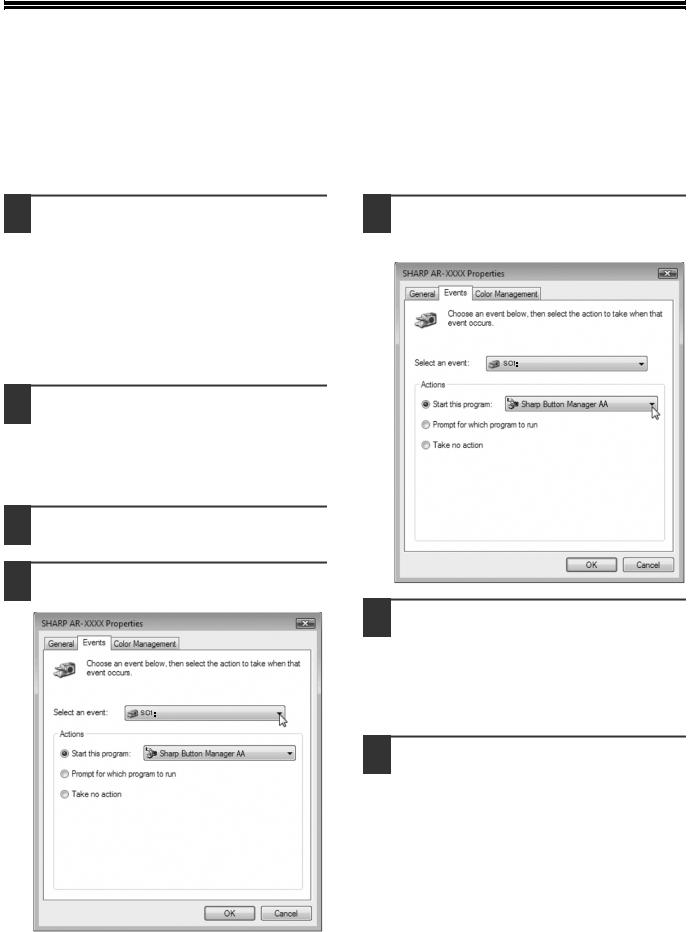
SETTING UP BUTTON MANAGER
Button Manager is a software program that works with the scanner driver to enable scanning from the machine. To scan using the machine, Button Manager must be linked with the scan menu on the machine. Follow the steps below to link Button Manager.
Windows XP/Vista/7
1 Click the "Start" button, click "Control Panel", click "Hardware and Sound", and then click "Scanners and Cameras".
•In Windows 7, click the "Start" button and then click "Devices and Printers".
•In Windows XP, click the "start" button, select "Control Panel" and click "Printers and Other Hardware", and then click "Scanners and Cameras".
2 Click the "SHARP AR-XXXX" icon and select "Properties".
•In Windows 7, right-click the "SHARP AR-XXXX" icon and select "Scan properties".
•In Windows XP, select "Properties" from the "File" menu.
3 In the "Properties" screen, click the "Events" tab.
4 Select "SC1:" from the "Select an event" pull-down menu.
5 Select "Start this program" and then select "Sharp Button Manager AA" from the pull-down menu.
6 Repeat Steps 4 and 5 to link Button Manager to "SC2:" through "SC6:".
Select "SC2:" from the "Select an event" pull-down menu. Select "Start this program", select "Sharp Button Manager AA" from the pull-down menu. Do the same for each scan menu through "SC6:".
7 Click the "OK" button.
Button Manager is now linked to the scan menu (1 through 6).
The scan settings for each of scan menu 1 through 6 can be changed with the setting window of Button Manager.
For the factory default settings of the scan menu and the procedures for configuring Button Manager settings, see "BUTTON MANAGER SETTINGS" (p.61).
12
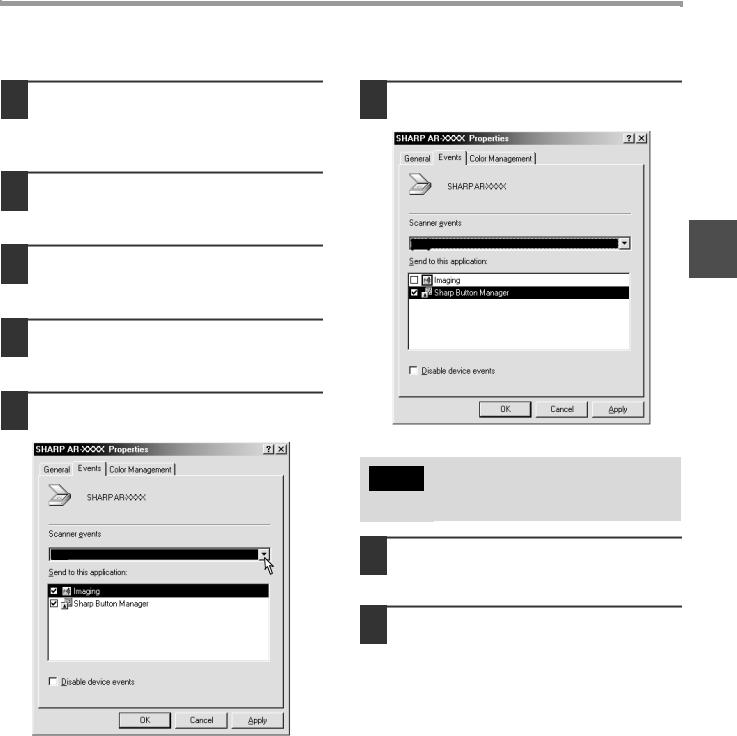
SETUP
Windows 2000
1 Click the "Start" button, select "Settings", and then click "Control Panel".
2 Double-click the "Scanners and
Cameras" icon.
3 Select "SHARP AR-XXXX" and click the "Properties" button.
4 In the "Properties" screen, click the "Events" tab.
5 Select "SC1:" from the "Scanner events" pull-down menu.
SC1:
AA
6 Select "Sharp Button Manager AA" in "Send to this application".
SC1: |
1 |
|
|
|
AA |
If other applications are shown, deselect the 
 Note checkboxes for the other applications and
Note checkboxes for the other applications and
leave only the Button Manager checkbox selected.
7 Click the "Apply" button.
8 Repeat Steps 5 through 7 to link Button Manager to "SC2:" through "SC6:".
Select "SC2:" from the "Scanner events" pull-down menu. Select "Sharp Button Manager AA" in "Send to this application" and click the "Apply" button. Do the same for each scan menu through "SC6:".
When the settings have been completed, click the "OK" button to close the screen.
Button Manager is now linked to the scan menu (1 through 6).
The scan settings for each of scan menu 1 through 6 can be changed with the setting window of Button Manager.
For the factory default settings of the scan menu and the procedures for configuring Button Manager settings, see "BUTTON MANAGER SETTINGS" (p.61).
13
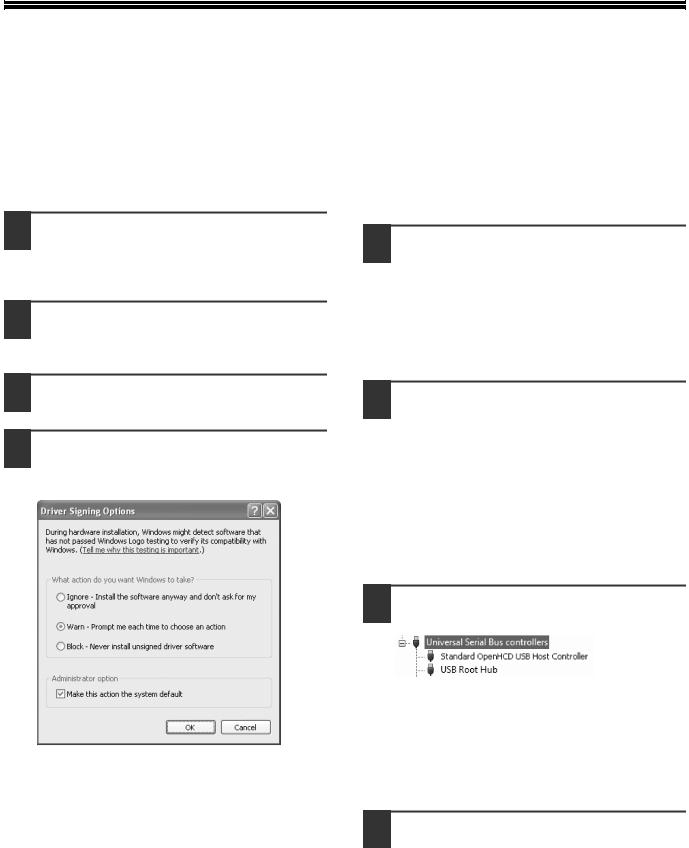
TROUBLESHOOTING
If the software is not installed correctly, check the following items on your computer.
The driver cannot be installed (Windows 2000/XP)
If the driver cannot be installed in Windows 2000/XP, follow these steps to check your computer's settings.
Plug and Play window does not appear
If the Plug and Play window does not appear after you connect the machine to your computer with a USB cable and turn on the machine, follow the steps below to verify that the USB port is available.
1 Click the "start" button and then click "Control Panel".
In Windows 2000, click the "Start" button, select "Settings", and then click "Control Panel".
2 Click "Performance and Maintenance", and then click "System".
In Windows 2000, double-click the "System" icon.
1 Click the "Start" button, select "Control Panel", and then click "System and Maintenance".
•In Windows XP, click the "start" button, click "Control Panel", and then click "Performance and Maintenance".
•In Windows 2000, click the "Start" button, select "Settings", and then click "Control Panel".
3 Click the "Hardware" tab and then click the "Driver Signing" button.
4 Check "What action do you want Windows to take?" ("File signature verification" in Windows 2000).
If the option "Block" has been selected, it will not be possible to install the driver. Select the option "Warn" and then install the driver as explained in "INSTALLING THE SOFTWARE" (p.7).
2 Click "Device Manager", and if a message screen appears asking you for confirmation, click "Continue".
"Universal Serial Bus controllers" will appear in the list of devices.
•In Windows XP, click "System", click the "Hardware" tab, and click the "Device Manager" button.
•In Windows 2000, double-click the "System" icon, click the "Hardware" tab, and click the "Device Manager" button.
3 Click the  icon beside "Universal Serial Bus controllers".
icon beside "Universal Serial Bus controllers".
Two items should appear: your controller chipset type and Root Hub. If these items appear, you can use the USB port. If the "Universal Serial Bus controllers" shows a yellow exclamation point or does not appear, you must check your computer manual for USB troubleshooting or contact your computer manufacturer.
4 Once you have verified that the USB port is enabled, install the software as explained in "INSTALLING THE SOFTWARE" (p.7).
14
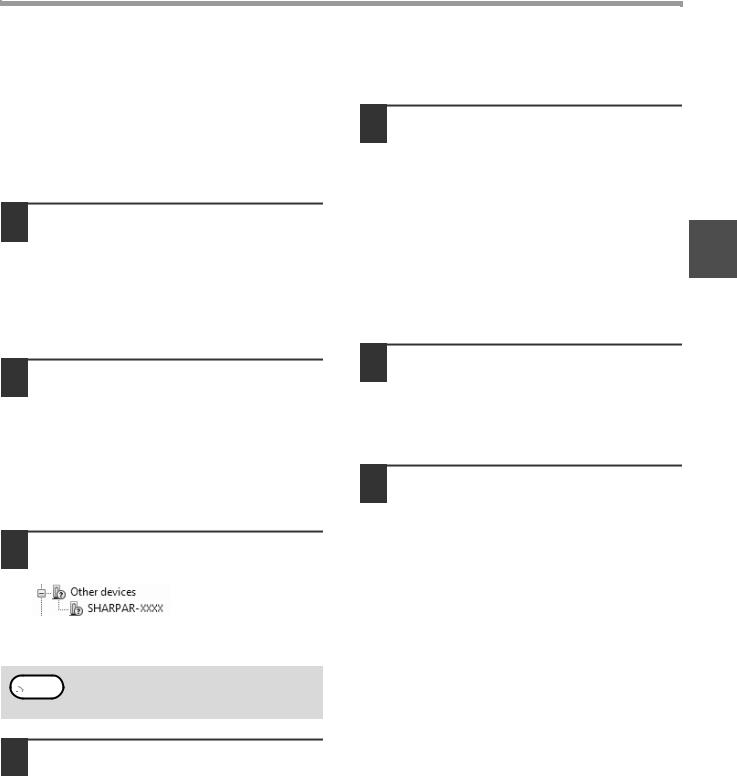
SETUP
The driver cannot be correctly installed by Plug and Play
If the driver cannot be correctly installed by Plug and Play (for example, Plug and Play takes place without copying the required files for the driver installation), follow these steps to remove unneeded devices and then install the driver as explained in "INSTALLING THE SOFTWARE" (p.7).
1 Click the "Start" button, select "Control Panel", and then click "System and Maintenance".
•In Windows XP, click the "start" button, click "Control Panel", and then click "Performance and Maintenance".
•In Windows 2000, click the "Start" button, select "Settings", and then click "Control Panel".
Removing the software
If you need to remove the software, follow these steps.
1 Click the "Start" button, and then click "Control Panel".
•In Windows XP, click the "start" button and then click "Control Panel".
•In Windows 2000, click the "Start" button, select "Settings", and then click "Control Panel".
2 |
Click "Uninstall a program". |
1 |
|
||
|
|
|
• In Windows XP, click "Add or Remove Programs".
• In Windows 2000, double-click the "Add/Remove Programs" icon.
2 Click "Device Manager", and if a message screen appears asking you for confirmation, click "Continue".
•In Windows XP, click "System", click the "Hardware" tab, and click the "Device Manager" button.
•In Windows 2000, double-click the "System" icon, click the "Hardware" tab, and click the "Device Manager" button.
3 Select the driver from the list, and remove the software.
For more information, refer to your operating manual or to the help files for your operating system.
4 Restart your computer.
3 Click the  icon beside "Other devices".
icon beside "Other devices".
If "SHARP AR-XXXX" appears, select and delete the item.
 Note If "Other devices" does not appear, close the "Device Manager" window.
Note If "Other devices" does not appear, close the "Device Manager" window.
4 Install the software as explained in "INSTALLING THE SOFTWARE" (p.7).
15
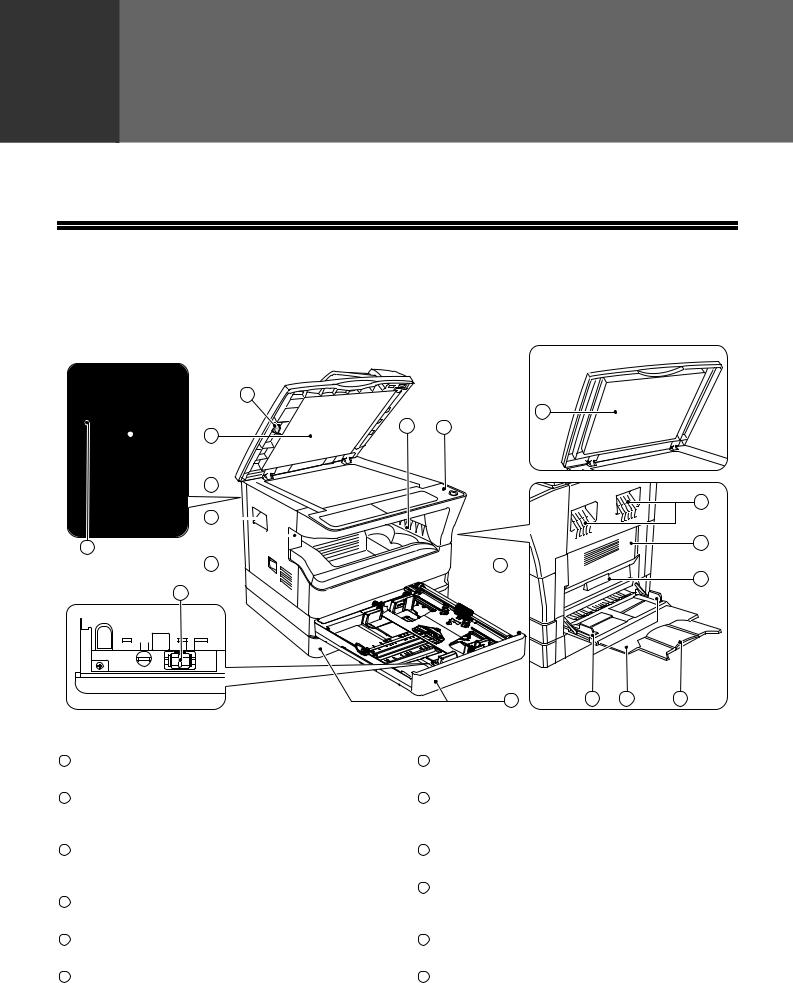
2 |
Chapter 2 |
BEFORE USING THE MACHINE |
This chapter contains basic information that should be read before using the machine.
PART NAMES AND FUNCTIONS
16
15 |
1
2 |
3
4
5
7 |
2 |
6 |
4 |
10
 8
8
11
9 12 13 14
1 |
Glass cleaner (when the SPF/RSPF is installed) |
7 |
Paper output tray |
|
Use to clean the original scanning glass. (p.98) |
|
Copies and prints are deposited to this tray. |
2 |
Document feeder cover (when the SPF/RSPF is |
8 |
Front cover |
|
installed) /document cover |
|
Open to remove paper misfeeds and perform |
|
Open to make copies from the document glass. (p.27) |
|
machine maintenance. (p.90, p.91, p.95) |
3 |
Document glass |
9 |
Paper trays |
|
Place an original that you wish to scan face down |
|
Each tray holds 250 sheets of paper. (p.22) |
|
here. (p.27) |
10 |
Side cover |
4 |
Handles |
|
Open to remove paper misfeeds and perform |
|
Use to move the machine. |
|
machine maintenance. (p.89, p.90) |
5 |
Power switch |
11 |
Side cover handle |
|
Press to turn the machine power on and off. (p.20) |
|
Pull to open the side cover. (p.89) |
6 |
Operation panel |
12 |
Bypass tray guides |
|
Contains operation keys and indicator lights. (p.18, p.19) |
|
Adjust to the width of the paper. (p.23) |
16
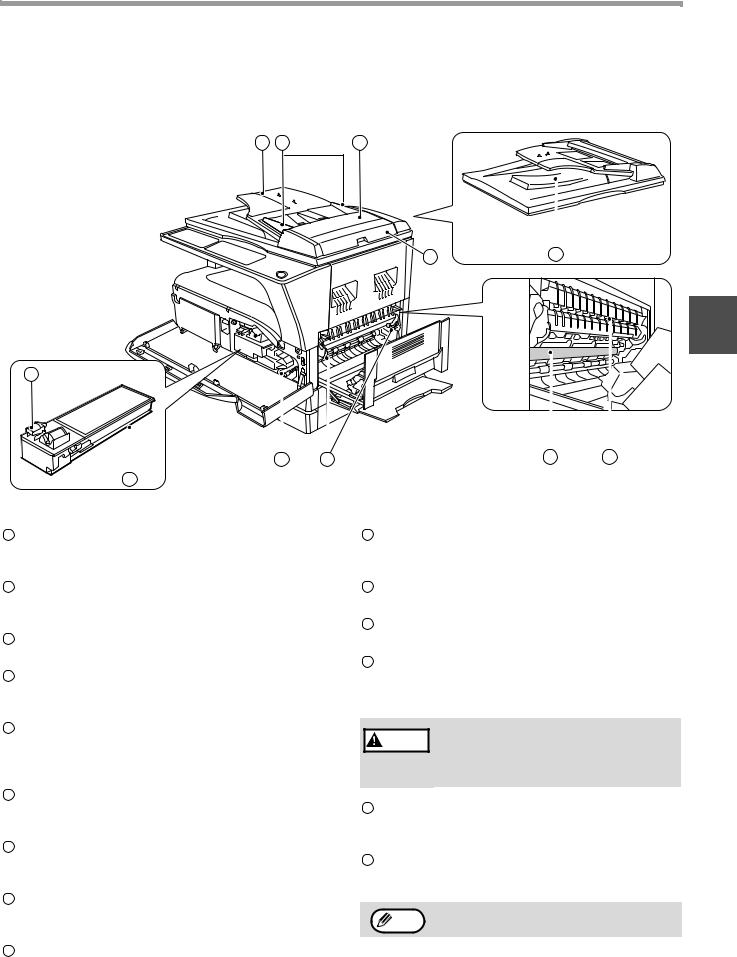
BEFORE USING THE MACHINE
17 |
18 |
19 |
20 |
21 |
2
22
24 25 26 27
23
13 Bypass tray 22 Toner cartridge lock release lever
Paper including special paper (such as transparency film) can be fed from the bypass tray. (p.23, p.38)
To replace the toner cartridge, pull out the toner cartridge while pushing on this lever. (p.95)
14 |
Bypass tray extension |
23 |
Toner cartridge |
|
Pull out when feeding large paper such as B4 and |
|
Contains toner. (p.95) |
|
A3 (8-1/2" x 14" and 11" x 17"). (p.23) |
24 |
Roller rotating knob |
15 |
Charger cleaner |
|
Turn to remove misfed paper. (p.90, p.91) |
|
Use to clean the transfer charger. (p.99) |
|
|
|
25 |
Fusing unit release levers |
|
16 |
USB 2.0 connector |
|
To remove a paper misfeed from the fusing unit, push |
|
Connect to your computer to use the printer |
|
down on these levers and remove the paper. (p.91) |
|
function. (p.9) |
|
|
17Document feeder tray (when the SPF/RSPF is installed)
Place the original(s) that you wish to scan face up here. Holds up to 40 originals. (p.29)
Warning |
The fusing unit is hot. Do not touch the fusing unit when removing misfed paper. Doing so may cause a burn or injury.
18Original guides (when the SPF/RSPF is installed)
Adjust to the size of the originals. (p.28)
19Feeding roller cover (when the SPF/RSPF is installed)
Open to remove misfed originals. (p.88)
20Right side cover (when the SPF/RSPF is installed)
Open to remove misfed originals. (p.88)
21Exit area (when the SPF/RSPF is installed)
Originals exit the machine here after copying.
26Photoconductive drum
Copy images are formed on the photoconductive drum.
27Fusing unit paper guide
Open to remove misfed paper. (p.92)
Note |
The model name can be seen on the machines |
front cover. |
17
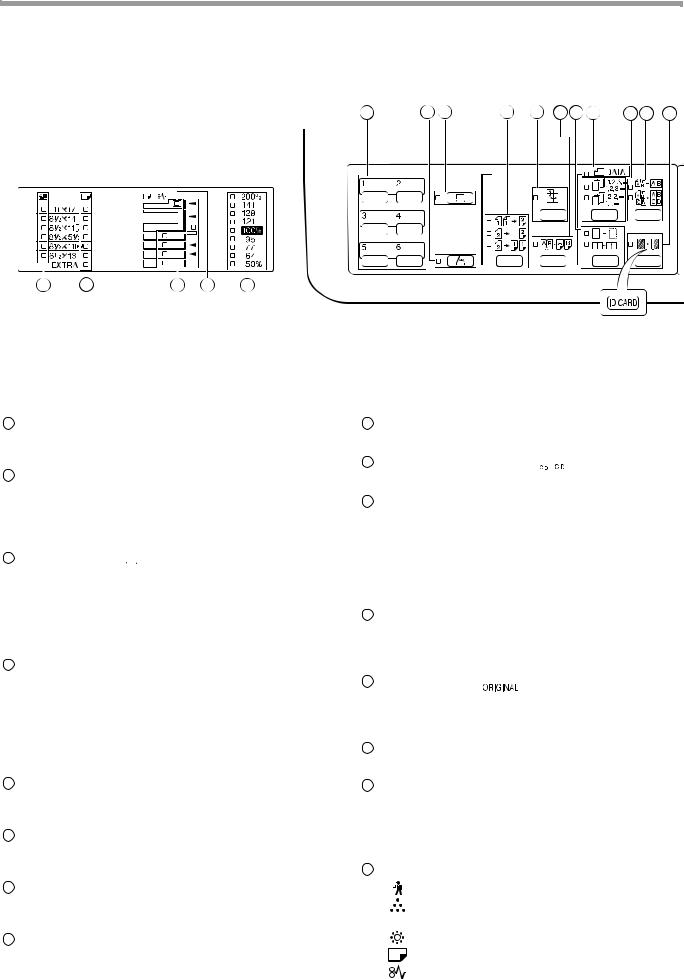
BEFORE USING THE MACHINE
OPERATION PANEL
|
1 |
2 |
3 |
4 |
5 |
6 |
7 |
8 |
9 |
10 |
11 |
||
The indications of the operation panel may differ |
|||||||||||||
|
|
|
|
|
|
|
|
|
|
|
|||
depending on the country and the region. |
|
|
|
|
|
|
|
|
|
|
|
|
|
|
|
|
|
|
|
|
|
|
|
|
|
|
|
The example of a display of inch series.
|
|
|
|
|
|
|
|
|
|
|
|
|
|
|
|
|
|
|
|
|
|
|
|
|
|
|
|
|
|
13 |
14 |
15 |
26 |
27 |
|||||
1SCAN MENU key
Use to scan by means of the provided Button Manager software. (p.61)
2SCAN key ( ) / indicator
) / indicator
Press to switch the machine to scanner mode and scan by means of the provided Button Manager software. (p.59) The indicator blinks during scanning and transmission of the scanned data.
3ON LINE key ( ) / indicator
) / indicator
Press to toggle the machine between online and off-line. The indicator lights up when the machine is online, and goes off when the machine is off-line. The indicator blinks while the machine is receiving print data and while printing is paused. (p.48)
4ORIGINAL TO COPY key / indicators (AR-5618D/AR-5620D/AR-5623D)
Press to select one-sided and two-sided copy modes. (p.36)



 Two-sided copies from one-sided originals.
Two-sided copies from one-sided originals.

 Two-sided copies from two-sided originals.
Two-sided copies from two-sided originals. 

 One-sided copies from two-sided originals.
One-sided copies from two-sided originals.
5XY-ZOOM key ( ) / indicator
) / indicator
Press to change the horizontal and vertical copy ratios independently. (p.33)
6DUAL PAGE COPY key (

 ) / indicator
) / indicator
Use to make individual copies of the two pages of an open book or other two-page original. (p.39)
7ERASE key (

 /
/

 ) / indicators
) / indicators
Press to select the "EDGE ERASE", "CENTRE ERASE" or "EDGE + CENTRE ERASE" mode. (p.46)
8ORIGINAL DATA indicator ( DATA )
DATA )
Blinks when the memory becomes full of scanned original image data. (p.42, p.44)
When the ID CARD COPY function is used
9 SORT/GROUP key (
 /
/
 ) / indicators
) / indicators
Press to select the "SORT" or "GROUP" mode. (p.41)
102 IN 1 / 4 IN 1 key (

 /
/

 ) / indicators
) / indicators
Press to select the "2 IN 1" or "4 IN 1" mode. (p.43)
11MARGIN SHIFT key (

 ) / indicator
) / indicator
Shifts text or image on the copy to leave a binding margin on the edge of the copy. (p.45)
To use the ID card copy function, attach the supplied [ID CARD] key label on the MARGIN SHIFT key. (The function cannot be used in some regions.)
12AUTO/TEXT/PHOTO key ( AUTO /

 /
/ ) / indicators
) / indicators
Use to select the exposure mode: "AUTO", "TEXT", or "PHOTO". (p.30)
13ORIGINAL key (  ) / ORIGINAL SIZE indicators
) / ORIGINAL SIZE indicators
Use to enter the original size. (p.24) The selected original size will light up.
14PAPER SIZE indicators
Light up to show the selected copy paper size. (p.24)
15Paper feed location / misfeed location indicators
The selected paper feed location is shown by a lit indicator (  ). (p.27)
). (p.27)
The general location of misfed paper is shown by a blinking red indicator (  ). (p.88)
). (p.88)
16Alarm indicators
[ |
] |
Maintenance indicator (p.87) |
[ |
] |
Toner cartridge replacement required |
|
|
indicator (p.87) |
[ |
] |
Developer replacement required indicator (p.87) |
[ |
] |
Paper required indicator (p.87) |
[ |
] |
Misfeed indicator (p.87) |
18

BEFORE USING THE MACHINE
|
|
|
|
|
|
|
|
|
|
|
|
|
|
|
|
|
|
12 |
13 |
14 |
15 |
16 |
17 |
18 |
19 |
20 |
|
||||||||
|
|
|
|
|
|
|
|
|
|
|
|
|
|
|
|
|
|
|
|
|
|
|
|
|
|
|
|
|
|
|
|
|
|
|
|
|
|
|
|
|
|
|
|
|
|
|
|
|
|
|
|
|
|
|
|
|
|
|
|
|
|
|
|
|
|
|
|
|
|
|
|
|
|
|
|
|
|
|
|
|
|
|
|
|
|
|
|
|
|
|
|
|
|
|
|
|
|
|
|
|
|
|
|
|
|
|
|
|
|
|
|
|
|
|
|
|
|
|
|
|
|
|
|
|
|
|
|
|
|
|
|
|
|
|
|
|
|
|
|
|
|
|
|
|
|
|
|
|
|
|
|
|
|
|
|
|
|
|
|
|
|
|
|
|
|
|
|
|
|
|
|
|
|
|
|
|
|
|
|
|
|
|
|
|
|
|
|
|
|
|
|
|
|
|
|
|
|
|
|
|
|
|
|
|
|
|
|
|
|
|
|
|
|
|
|
|
|
|
|
|
|
|
|
|
|
|
|
|
|
|
|
|
|
|
|
|
|
|
|
|
|
|
|
|
|
|
|
|
|
|
|
|
|
|
|
|
|
|
|
|
|
|
|
|
|
|
|
|
|
|
|
|
|
|
|
|
|
|
|
|
|
|
|
|
|
|
2 |
21 |
22 |
|
24 |
25 |
26 |
27 |
28 |
29 |
30 31 |
32 |
33 |
34 |
35 |
|||||||||||||
|
|
23 |
When there are two or more paper trays |
|
|
|
|
|
|
|
|
|||||||||||||||
17Display
Shows the set number of copies, as well as the copy ratio, system setting function or setting code, or an error code when an error occurs.
18Numeric keys
Use to select the desired copy quantity or to make system setting entries. (p.31)
To display the total number of pages output by the machine, hold the [0] key down. (p.96)
19CLEAR key (  )
)
27PRESET RATIO selector keys (  ,
,  ) / indicators
) / indicators
Use to select preset reduction/enlargement copy ratios. (p.32)
28Zoom keys (  ,
,  )
)
Use to select any reduction or enlargement copy ratio from 25% to 400% in increments of 1%. (p.33)
29Copy ratio display key ( )
)
Hold down when the machine is not in use to display the copy ratio in the display. (p.33)
Clears the copy quantity display or terminates a copy run.
20INTERRUPT key ( ) / indicator
) / indicator
Interrupts a copy run. (p.40)
21Light and Dark keys (  ,
,  ) / indicators
) / indicators
Use to adjust the TEXT or PHOTO exposure level. (p.30)
22PAPER SELECT key (  )
)
Use to set the paper size in the paper trays. (p.24, p.30)
23AUTO PAPER SELECT indicator (AUTO  )
)
Paper of the proper size will be automatically selected depending on the original size and selected copy ratio when this indicator is on. (p.29)
24TRAY SETTING key (
 )
)
Use to manually select a paper tray. (p.24)
25AUTO IMAGE key (AUTO % ) / indicator
Press for automatic copy ratio selection. (p.31)
26SPF/RSPF indicator (when the SPF/RSPF is installed)
Lights up when originals are set in the document feeder tray. (p.28)
30ZOOM indicator
Lights up when a zoom ratio is set. (p.33)
31Audit clear key ( ) (ACC.#-C )
) (ACC.#-C )
Closes an open account. (p.78)
32READ-END key ( )
)
Use to check the total number of copies made. (p.96)
When copying in sort mode and 2 in 1/4 in 1 from the document glass, press this key when you have finished scanning the original pages and are ready to start copying. (p.42, p.43)
33CLEAR ALL key ( )
)
Clears all selected settings and returns the machine to the initial settings. (p.20)
34POWER SAVE indicator ( )
)
Lights up when the machine is in a power save mode. (p.20)
35START key ( ) / indicator
) / indicator
Press to make a copy (p.28). Also press to exit "Auto power shut-off" mode and to set a system setting. Copying is possible when the indicator is on.
19

POWER ON AND OFF
The power switch is located on the left side of the machine.
POWER ON
Turn the power switch to the "ON" position.
It will take about 25 seconds for the machine to warm up. While the machine is warming up, the POWER SAVE
indicator ( ) will blink. (The POWER SAVE indicator (
) will blink. (The POWER SAVE indicator ( ) will go off when the machine is ready to copy.)
) will go off when the machine is ready to copy.)
However, you can make desired settings and press the [START] key ( ) during warm-up. Copying will start after warm-up.
) during warm-up. Copying will start after warm-up.
POWER OFF
Make sure that the machine is not in operation and then turn the power switch to the "OFF" position.
If the power switch is turned off while the machine is in operation, a misfeed may occur and the job that was in progress will be cancelled.
Check the following to make sure the machine is not in operation:
•The START indicator is lit. (Initial state)
•The POWER SAVE indicator ( ) is lit. ("Preheat mode" or "Auto power shut-off" mode)
) is lit. ("Preheat mode" or "Auto power shut-off" mode)
• The machine reverts to the initial settings when it is first turned on, when the [CLEAR ALL] key ( ) is pressed,
) is pressed,  Note or when no keys are pressed for the preset "Auto clear" time following the end of a copy job. When the machine reverts to the initial settings, all settings and functions selected to that point are cancelled. The "Auto clear" time
Note or when no keys are pressed for the preset "Auto clear" time following the end of a copy job. When the machine reverts to the initial settings, all settings and functions selected to that point are cancelled. The "Auto clear" time
can be changed in the user settings. (p.70)
•The machine is initially set to automatically enter power save mode if not used for copying or printing, for a preset period of time. This setting can be changed in the system settings. (p.70)
Power save modes
The machine has two power save modes to reduce overall power consumption thereby reducing the cost of operation. In addition, these modes conserve natural resources and help reduce environmental pollution. The two power save modes are "Preheat mode" and "Auto power shut-off mode".
Preheat mode
This function automatically switches the machine to a low power consumption state if the set duration of time elapses without the machine being used when the power is on. The POWER SAVE indicator ( ) lights up, however, the keys on the operation panel can be used. Normal operation automatically resumes when a key on the operation panel is pressed, an original is placed, or a print job is received.
) lights up, however, the keys on the operation panel can be used. Normal operation automatically resumes when a key on the operation panel is pressed, an original is placed, or a print job is received.
Auto power shut-off mode
This function automatically switches the machine to a state that consumes even less power than preheat mode if the set duration of time elapses without the machine being used when the power is on. All lights except the POWER SAVE indicator ( ) and ON LINE indicator go off. To resume normal operation, press the [START] key (
) and ON LINE indicator go off. To resume normal operation, press the [START] key ( ). Normal operation also resumes automatically when a print job is received. While in auto power shut-off mode, no keys (except the [START] key (
). Normal operation also resumes automatically when a print job is received. While in auto power shut-off mode, no keys (except the [START] key ( )) can be used.
)) can be used.
Note |
The preheat activation time and the "Auto power shut-off timer" can be changed using system settings. It is |
suggested that you set times that are appropriate for your usage of the machine. (p.70) |
|
|
|
Initial settings
The machine assumes the initial settings when it is first turned on, when the [CLEAR ALL] key ( ) is pressed, and approximately one minute after the last copy is made in any mode.
) is pressed, and approximately one minute after the last copy is made in any mode.
Copy ratio: 100%, Exposure: Automatic
Copy quantity: 0, All special copier modes: Off
Auto paper selection: On, Paper feed station: The tray selected in the "Default tray setting" in the system settings. (p.72)
20

LOADING PAPER
The paper required indicator (  ) will light up when there is no copy paper in the selected paper feed tray, or when the selected paper tray is not installed or is improperly installed.
) will light up when there is no copy paper in the selected paper feed tray, or when the selected paper tray is not installed or is improperly installed.
PAPER
For best results, use only SHARP recommended paper.
Paper tray type |
Paper type |
Size |
Weight |
Capacity |
|
|
Paper tray |
Standard paper |
A5*1 |
56 g/m2 to 90 g/m2 *2 |
250 sheets |
|
|
250-sheet paper |
Recycled paper |
B5 |
(15 lbs. to 24 lbs. *2) |
(Load paper lower |
|
|
feed unit |
|
A4 |
|
than the line on the |
|
|
2 x 250-sheet |
|
B4 |
|
tray) |
|
|
paper |
|
A3 |
|
|
|
|
feed unit |
|
(5-1/2" x 8-1/2"*1 (Invoice)) |
|
|
|
|
|
|
|
|
2 |
||
|
|
(8-1/2" x 11" (Letter)) |
|
|
|
|
|
|
(8-1/2" x 13" (Foolscap)) |
|
|
|
|
|
|
(8-1/2" x 14" (Legal)) |
|
|
|
|
|
|
(11" x 17" (Ledger)) |
|
|
|
|
|
|
|
|
|
|
|
|
|
|
|
|
|
|
Bypass tray |
Standard paper |
A6R to A3 |
56 g/m2 to 90 g/m2 |
100 sheets *3 |
|
|
|
Recycled paper |
(5-1/2" x 8-1/2" (Invoice) |
(15 lbs. to 24 lbs.) |
|
|
|
|
|
to 11" x 17" (Ledger)) |
|
|
|
|
|
Transparency film |
|
Load one sheet of |
|
|
|
|
Labels |
|
|
paper each time on |
|
|
|
|
|
|
the bypass tray. |
|
|
|
|
|
|
|
|
|
|
Thick paper |
A6R to A4 |
129 g/m2 to 200 g/m2 |
Load one sheet of |
|
|
|
|
(5-1/2" x 8-1/2" (Invoice) |
(33 lbs. to 110 lbs. *4) |
paper each time on |
|
|
|
|
to 8-1/2" x 11" (Letter)) |
|
the bypass tray. |
|
|
|
|
|
|
|
|
|
|
|
|
106 g/m2 to 128 g/m2 |
You can load multiple |
|
|
|
|
|
(28 lbs. to 33 lbs.) |
sheets of paper on |
|
|
|
|
|
|
the bypass tray. |
|
|
|
|
|
|
|
|
|
|
|
A6R to A3 |
91 g/m2 to 105 g/m2 |
You can load multiple |
|
|
|
|
(5-1/2" x 8-1/2" (Invoice) |
(24 lbs. to 28 lbs.) |
sheets of paper on |
|
|
|
|
to 11" x 17" (Ledger)) |
|
the bypass tray. |
|
|
|
|
|
|
|
|
|
|
Envelopes |
International DL |
|
5 sheets |
|
|
|
|
(110 mm x 220 mm) |
|
|
|
|
|
|
International C5 |
|
|
|
|
|
|
(162 mm x 229 mm) |
|
|
|
|
|
|
Monarch |
|
|
|
|
|
|
(3-7/8" x 7-1/2") |
|
|
|
|
|
|
Commercial 10 |
|
|
|
|
|
|
(4-1/8" x 9-1/2") |
|
|
|
|
|
|
|
|
|
|
|
*1 A5 (5-1/2" x 8-1/2") can be used in the upper paper tray but cannot be used in other trays (including trays in optional paper feeding unit).
*2 When making a large number of copies or prints using 90 g/m2 (24 lbs.) paper, remove the output from the paper output tray when about 100 pages have been printed. The output may not stack correctly if more than 100 pages are allowed to accumulate.
*3 The number of sheets of the paper which can be set changes with the weight of a paper. *4 Index
Special papers
Follow these guidelines when using special papers.
●Use SHARP recommended transparency film and label sheets. Using other than SHARP recommended paper may result in misfeeds or smudges on the output. If other than SHARP recommended media must be used, feed each sheet one at a time using the bypass tray (do not attempt continuous copying or printing).
●There are many varieties of special paper available on the market, and some cannot be used with this machine. Before using special paper, contact your authorised service representative.
●Before using other than SHARP recommended paper, make a test copy to see if the paper is suitable.
21
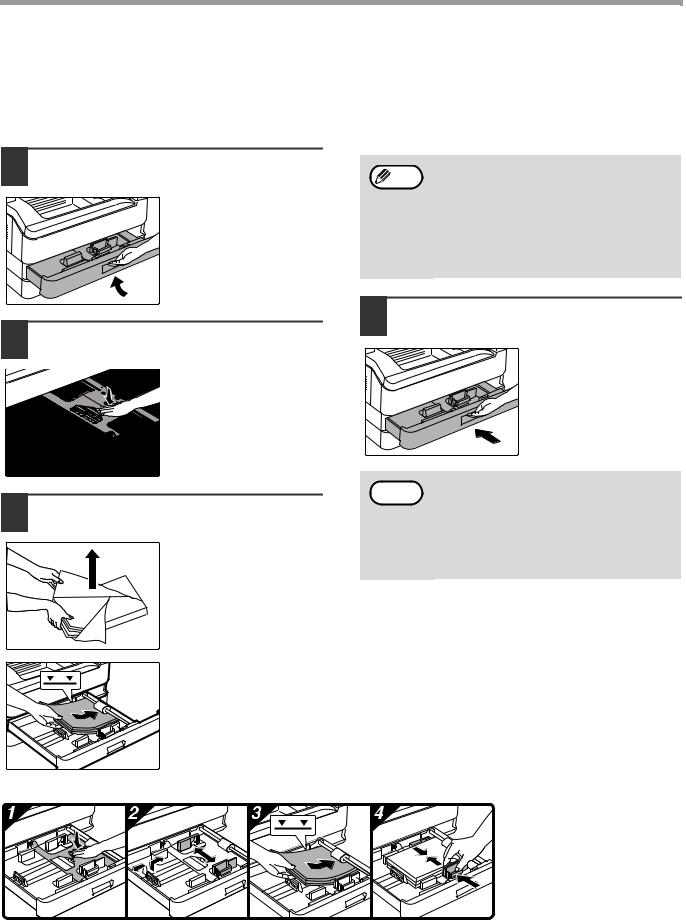
BEFORE USING THE MACHINE
LOADING PAPER
Make sure that the machine is not copying or printing, and then follow these steps to load paper.
Loading the paper tray
1 Gently lift and pull out the paper tray until it stops.
2 Push the pressure plate down until it locks in place.
Push the centre of the pressure plate down until it locks into place.
3 Load paper into the tray.
• Open the package of the paper and load it without fanning the paper.
• Make sure the stack of paper is straight before loading it.
• |
Do not load paper higher than the line on |
Note |
the tray (up to 250 sheets). |
•Do not add paper to the loaded paper. It may cause multiple feed of paper.
•A5 (5-1/2" x 8-1/2") can be used in the upper paper tray but cannot be used in other trays (including trays in optional paper feeding unit).
4 Gently push the paper tray into the machine.
• If you loaded a different size of paper than  Note was loaded previously in the tray, go to
Note was loaded previously in the tray, go to
"CHANGING A TRAY'S PAPER SIZE SETTING" (p.24).
•When misfeed occurs, rotate the paper 180 degrees and reload it.
•Straighten curled paper before using it.
For how to load paper, refer to the steps below.
22
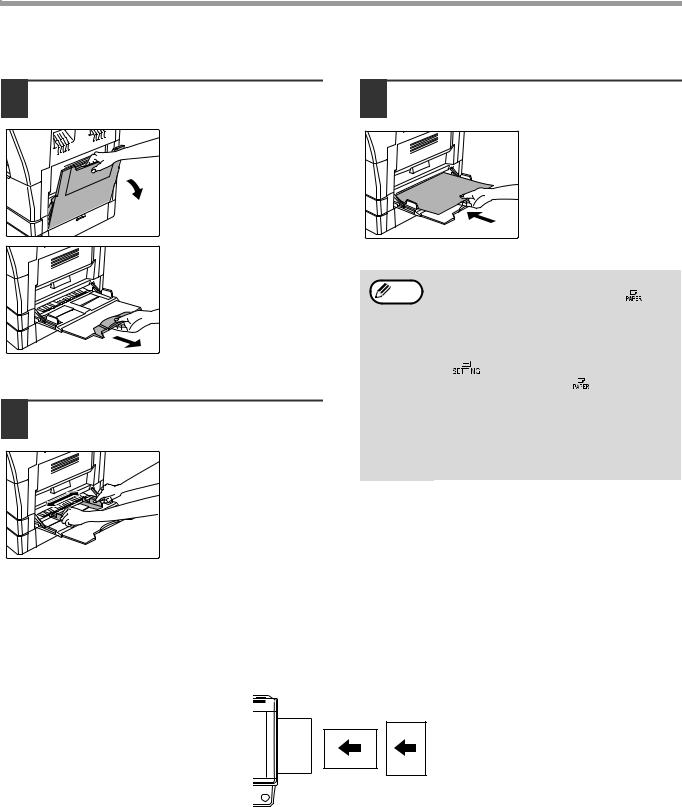
BEFORE USING THE MACHINE
Loading the bypass tray
1 Unfold the bypass tray.
When feeding large paper such as B4 and A3 (8-1/2" x 14" and
11" x 17"), pull out the bypass tray extension.
2 Set the paper guides to the copy paper width.
3 Insert the paper (print face down) all the way into the bypass tray.
To prevent a misfeed, verify once more that the paper guides are adjusted to the width of the paper.
• |
If you loaded paper in the bypass tray, |
|
|||
Note |
press the [PAPER SELECT] key ( ) to |
|
|||
2 |
|||||
|
select the bypass tray. The bypass tray will |
||||
|
not be selected automatically. |
||||
• |
If you load thick paper in the bypass tray, |
||||
|
hold down the [TRAY SETTING] key |
|
|||
|
|
||||
|
( |
|
) for more than 5 seconds, use the |
|
|
|
|
|
|||
|
[PAPER SELECT] key ( ) to select the |
|
|||
|
bypass tray, and press the [AUTO IMAGE] |
|
|||
key (AUTO % ). When AUTO IMAGE indicator (AUTO % ) lights up, the paper type is set to thick paper. The setting is cleared when "Auto clear" works or the [CLEAR ALL] key ( ) is pressed.
) is pressed.
Important points when inserting paper in the bypass tray
•Up to 100 sheets of standard copy paper can be set in the bypass tray.
•Be sure to place A6, B6 or 5-1/2" x 8-1/2" size paper or envelopes horizontally as shown in the following diagram ( ).
).
Available Not
available
•When loading envelopes, make sure that they are straight and flat and do not have loosely glued construction flaps (not the closure flap).
•Special papers except SHARP recommended transparency film, labels, and envelopes must be fed one sheet at a time through the bypass tray.
•When adding paper, first remove any paper remaining in the tray, combine it with the paper to be added and then reload as a single stack. The paper to be added must be the same size and type as the paper already in the tray.
•Do not use paper that is smaller than the original. This may cause smudges or unclean images.
•Do not use paper that has already been printed on by a laser printer or plain paper fax machine. This may cause smudges or unclean images.
23
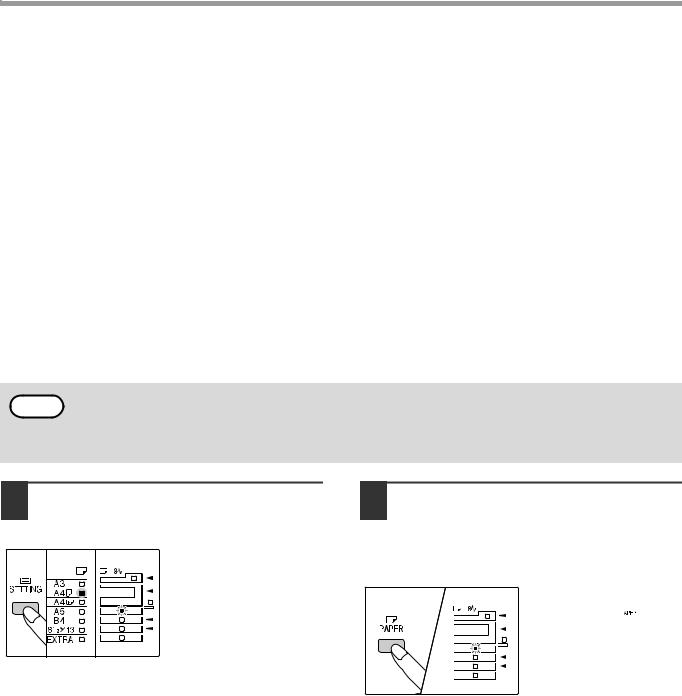
BEFORE USING THE MACHINE
Envelopes
Do not use the following envelopes, as misfeeds will occur.
•Envelopes with metal tabs, clasps, strings, holes, or windows.
•Envelopes with rough fibres, carbon paper, or glossy surfaces.
•Envelopes with two or more flaps.
•Envelopes with tape, film, or paper attached to the flap.
•Envelopes with a fold in the flap.
•Envelopes with glue on the flap to be moistened for sealing.
•Envelopes with labels or stamps.
•Envelopes that are slightly inflated with air.
•Envelopes with glue protruding from the seal area.
•Envelopes with part of the seal area peeled off.
CHANGING A TRAY'S PAPER SIZE SETTING
Follow these steps to change a tray's paper size setting.
• The paper size setting cannot be changed when the machine has stopped temporarily due to running out of  Note paper or a misfeed, or during interrupt copying.
Note paper or a misfeed, or during interrupt copying.
•During printing (even in copy mode), the paper size setting cannot be changed.
•A5 (5-1/2" x 8-1/2") size paper can only be selected in upper paper tray.
•Do not load paper that is a different size than the paper size setting. Copying will not be possible.
1 Hold down the [TRAY SETTING] key (


 ) for more than 5 seconds to set the selected paper size.
) for more than 5 seconds to set the selected paper size.
The currently selected paper feed location indicator will blink and the corresponding paper size (which is currently set) indicator will light steadily. All other indicators will go out.
2 If the machine has two or more paper trays, use the [PAPER SELECT] key (

 ) to select the paper tray for which you wish to change the paper size setting.
) to select the paper tray for which you wish to change the paper size setting.
Each time the [PAPER SELECT] key (  ) is pressed, a paper tray will be indicated with a blinking paper feed location indicator.
) is pressed, a paper tray will be indicated with a blinking paper feed location indicator.
24
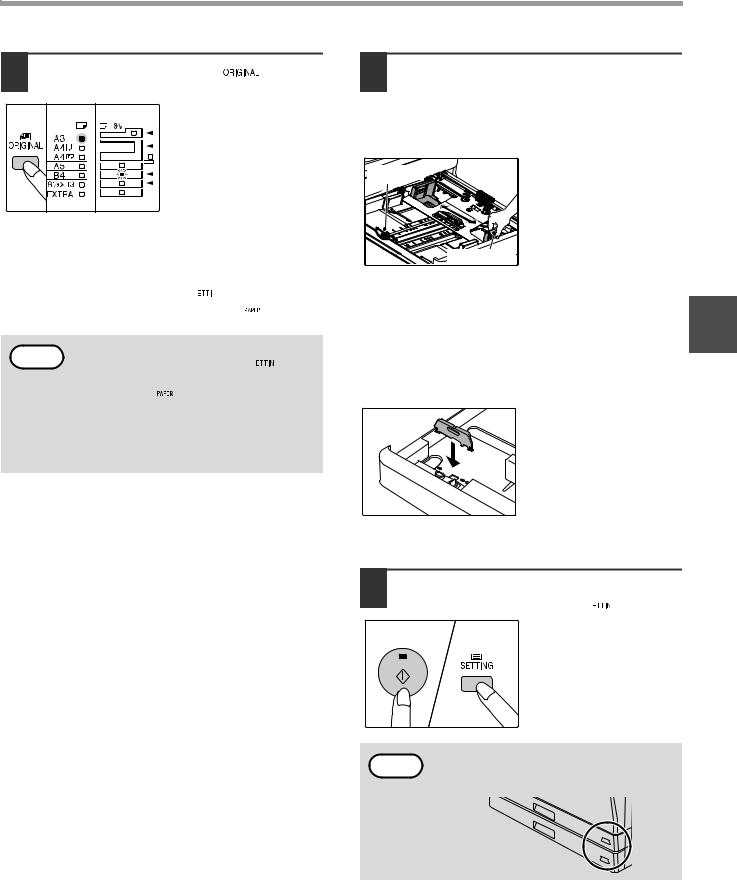
BEFORE USING THE MACHINE
3 Use the [ORIGINAL] key (  ) to select the paper size.
) to select the paper size.
The indicator of the selected paper size lights up.
Changing bypass tray's paper size setting
To change the bypass tray's paper size setting, hold down the [TRAY SETTING] key (

 ) for more than 5 seconds, use the [PAPER SELECT] key (
) for more than 5 seconds, use the [PAPER SELECT] key (  ) to select the bypass tray, and select the desired paper size.
) to select the bypass tray, and select the desired paper size.
If you load thick paper in the bypass tray, hold  Note down the [TRAY SETTING] key (
Note down the [TRAY SETTING] key (

 ) for
) for
more than 5 seconds, use the [PAPER SELECT] key (  ) to select the bypass tray, and press the [AUTO IMAGE] key (AUTO % ). When AUTO IMAGE indicator (AUTO % ) lights up, the paper type is set to thick paper. The setting is cleared when "Auto clear" works or the [CLEAR ALL] key (
) to select the bypass tray, and press the [AUTO IMAGE] key (AUTO % ). When AUTO IMAGE indicator (AUTO % ) lights up, the paper type is set to thick paper. The setting is cleared when "Auto clear" works or the [CLEAR ALL] key ( ) is pressed.
) is pressed.
Customise the bypass tray setting
If the bypass tray is selected, you can also change the paper size setting with the following procedure.
•Enter a value for the horizontal/vertical direction by pressing the numeric keys.
Press the [ ] key to switch the horizontal/vertical direction.
] key to switch the horizontal/vertical direction.
The horizontal direction is selected: zoom indicator lights up
The vertical direction is selected: zoom indicator does not light up
When finished, press and hold [ ].
].
Available value
Direction |
min. (mm) |
max. (mm) |
horizontal |
100 |
297 |
|
|
|
vertical |
139 |
420 |
|
|
|
*Value can be entered only in metric (AB series).
Metric (AB series) and inch series reference
Inch series (inch) |
Metric series |
|
(AB series) (mm) |
||
|
||
|
|
|
5-1/2" x 8-1/2" (Invoice) |
140 x 216 |
|
|
|
|
8-1/2" x 11" (Letter) |
216 x 279 |
|
|
|
|
8-1/2" x 13" (Foolscap) |
216 x 330 |
|
|
|
|
8-1/2" x 14" (Legal) |
216 x 355 |
|
|
|
|
11" x 17" (Ledger) |
279 x 432 |
|
|
|
4 Squeeze the lock lever of the front guide and slide the front guide to match the width of the paper, and move the left guide to the appropriate slot as marked on the tray.
Left guide
Front guide |
|
• The front guide is a slide-type guide. Grasp the |
|
locking knob on the guide and slide the guide to the |
2 |
indicator line of the paper to be loaded. |
|
• The left guide is an insert-type guide. Remove it and |
|
then insert it at the indicator line of the paper to be |
loaded.
• When using 11" x 17" sized paper store the left guide in the slot at the left front of the paper tray.
•If the bypass tray is selected, set the paper guides to the copy paper width.
5 Press the [START] key ( ) and then the [TRAY SETTING] key (
) and then the [TRAY SETTING] key (

 ).
).
To change the paper size setting of another tray, repeat steps 2 to 5 after pressing the [START] key ( ).
).
Affix the paper size label for the paper size  Note selected in step 3 to the label position on the
Note selected in step 3 to the label position on the
right end of the tray.
Important points when using the printer mode
Make sure that the tray's paper size setting is the same as the tray's paper size setting in the printer driver. For example, if the tray's paper size setting is A4R (8-1/2" x 11"R), set "Set Paper Size" to "A4R" ("Letter-R"). For more information, see "CONFIGURING THE PRINTER DRIVER" (p.11).
25

OPERATION IN COPY, PRINTER, AND SCANNER MODES
Some operations cannot be performed simultaneously when the machine is being used in printer mode, copy mode, or scanner mode.
Modes |
Copying |
Printing |
Scanning from |
Scanning from |
|
a computer |
the machine |
||||
|
|
|
Copy |
Copy key input |
Yes |
Yes |
Yes |
No |
During copying |
|
No |
No |
No |
|
|
|
||||
Printer |
During printing |
Yes* |
|
Yes |
Yes |
Scanner |
During scan preview/ |
No |
Yes |
|
|
during scanning |
|
|
|||
|
|
|
|
|
* During two-sided printing (AR-5618D/AR-5620D/AR-5623D), the copy job begins after the print job finishes.
26
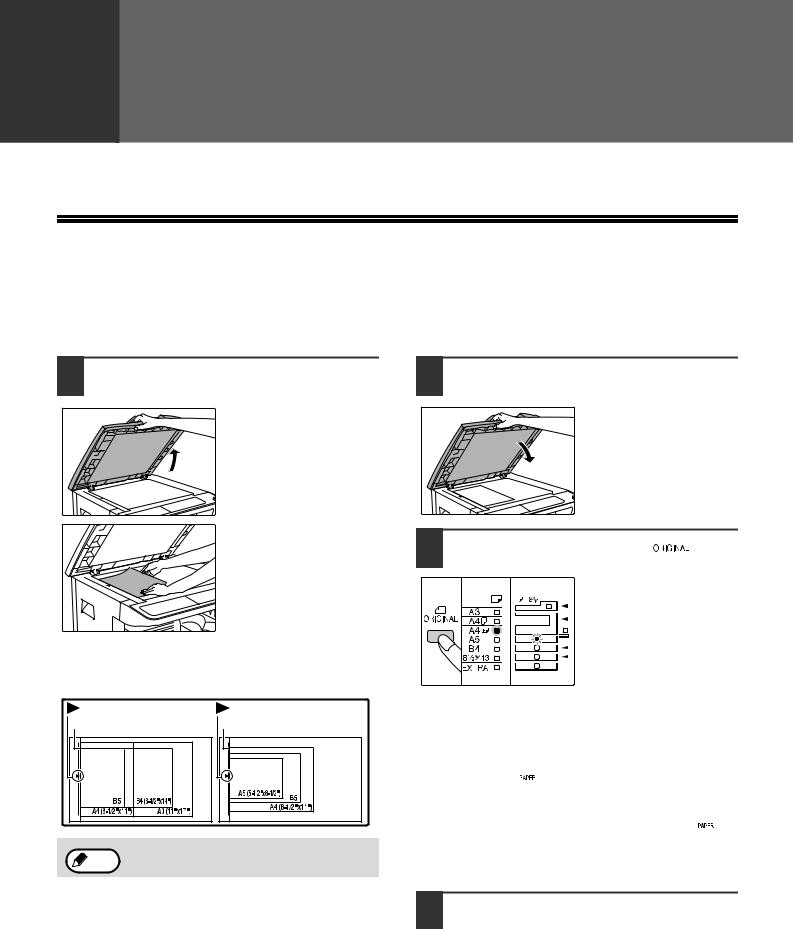
3 |
Chapter 3 |
COPY FUNCTIONS |
This chapter explains how to use the copy functions.
NORMAL COPYING
This section explains how to make a regular copy.
If "Auditing mode" has been enabled (p.75), enter your 3-digit account number.
Copying from the document glass
1 Open the document cover/SPF/RSPF, and place the original.
Place the original face down on the document glass.
[How to place the original]
Align the edge of the original with the original size scale, to be centred with the centring mark ( ).
).
mark |
mark |
Original size scale |
Original size scale |
An original up to A3 (11" x 17") can be placed 
 Note on the document glass.
Note on the document glass.
2 Close the document cover/SPF/RSPF.
After placing the original, be sure to close the document cover/SPF/ RSPF. If left open, parts outside of the original will be copied black, causing excessive use of toner.
3 Press the [ORIGINAL] key (  ) and select the original size.
) and select the original size.
When the original size is selected, the tray with the same size of paper is automatically selected. (When there are two or more paper trays)
●Make sure that the PAPER SIZE indicator lights up. If the indicator is not lit, no tray has the same size of paper as the original. Load paper of the required size in a tray, or select the bypass tray with the [PAPER SELECT] key (  ) and copy from the bypass tray.
) and copy from the bypass tray.
●The bypass tray must be manually selected.
●To copy on paper of a different size than the original, select the paper with the [PAPER SELECT] key (  ).
).
●If the ORIGINAL SIZE indicator is blinking, rotate the original so that it is in the same orientation as the blinking ORIGINAL SIZE indicator.
4 Set the number of copies.
27
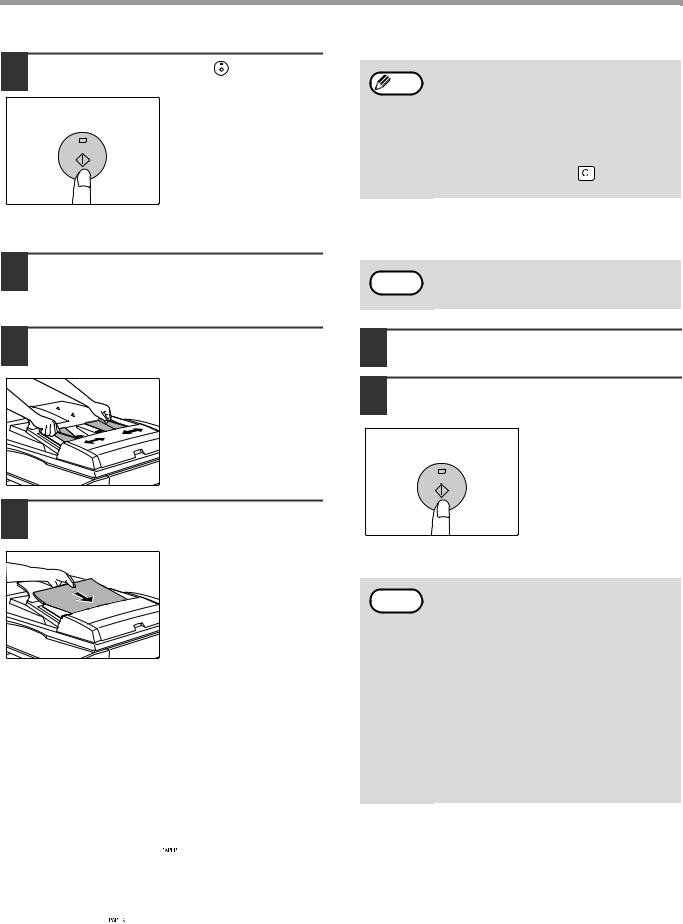
COPY FUNCTIONS
Press the [START] key ( ) to begin |
• |
The paper output tray can hold up to 250 |
5 copying. |
Note |
sheets of paper. |
The copy is delivered to |
• |
About one minute after copying ends, "Auto |
the paper output tray. |
|
clear" activates and restores the copy |
|
|
settings to the initial settings. (p.20) The |
|
|
setting for "Auto clear time" can be changed |
|
|
in the system settings. (p.70) |
|
• |
Press the [CLEAR] key ( ) to stop |
|
|
copying in the middle of a run. |
Copying from the SPF/RSPF
1 Make sure that an original has not been left on the document glass. Close the SPF/RSPF.
2 Adjust the original guides to the size of the original(s).
3 Set the original(s) face up in the document feeder tray.
●Insert the original into the document feeder tray as far as it will go. When the original is set, the SPF/ RSPF indicator will light up.
●The ORIGINAL SIZE indicator corresponding to the size of the original lights up.
●If the ORIGINAL SIZE indicator is blinking, rotate the original so that it is in the same orientation as the blinking ORIGINAL SIZE indicator.
●Make sure that the PAPER SIZE indicator is lit.
If the indicator is not lit, no tray has the same size of paper as the original. Load paper of the required size in a tray, or select the bypass tray with the [PAPER SELECT] key (  ) and copy from the bypass tray.
) and copy from the bypass tray.
●The bypass tray must be manually selected.
●To copy on paper of a different size than the original, select the paper with the [PAPER SELECT] key (  ).
).
Do not place originals of different sizes  Note together in the document feeder tray. This
Note together in the document feeder tray. This
may cause misfeeds.
4 Set the number of copies.
5 Press the [START] key ( ) to begin copying.
) to begin copying.
The copy is delivered to the paper output tray. The default output mode for copying from the SPF/ RSPF is sort mode (p.41).
The default output mode can be changed using "Sort auto select" in the system settings (p.73).
• The paper output tray can hold up to 250  Note sheets of paper.
Note sheets of paper.
•About one minute after copying ends, "Auto clear" activates and restores the copy settings to the initial settings. (p.20) The setting for "Auto clear" time can be changed in the system settings. (p.70)
•Press the [CLEAR] key ( ) to stop copying in the middle of a run.
) to stop copying in the middle of a run.
•If you find it difficult to remove the original from the document feeder tray, open the feeding roller cover first and then remove the original. If you remove the original without opening the feeding roller cover, the original may become dirty.
28
